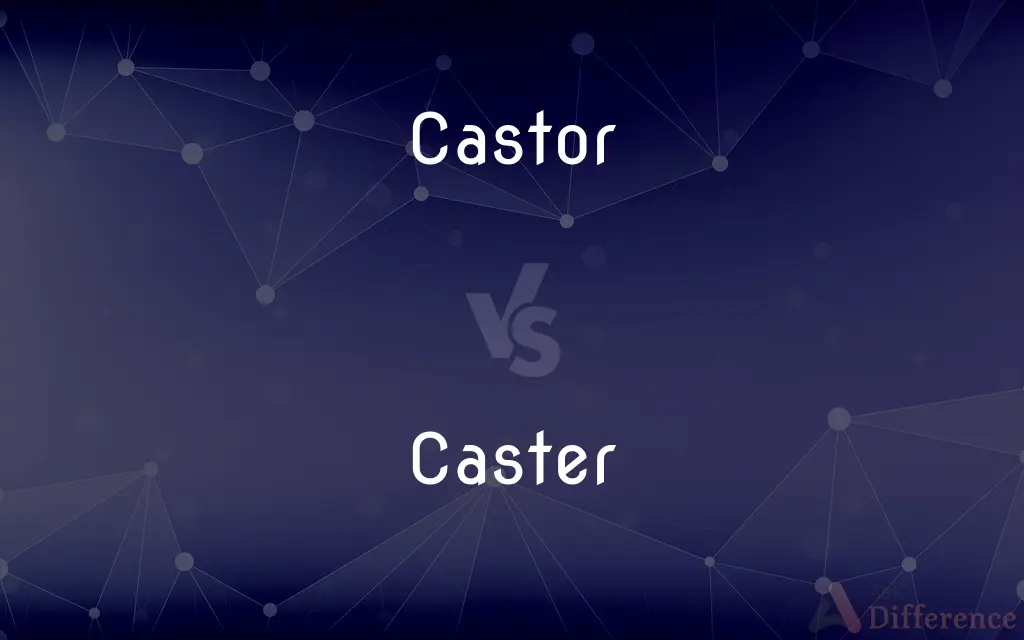Castor vs. Caster — What's the Difference?
By Tayyaba Rehman & Fiza Rafique — Updated on March 25, 2024
Castor is a type of beaver or a pivoting wheel for furniture movement, while caster refers specifically to the wheel mechanism. Both share mobility aspects, yet differ in nature and application.

Difference Between Castor and Caster
Table of Contents
ADVERTISEMENT
Key Differences
Castor primarily refers to two distinct concepts: a type of large beaver known for its fur and construction of dams, and a pivoting wheel attached to furniture for easy movement. Whereas caster is used exclusively to describe the wheel mechanism on furniture or machinery that provides mobility. This terminology distinction highlights their different realms of application, with castor bridging natural and manufactured contexts.
In terms of etymology, 'castor' can trace its roots back to both natural and mythological origins, depending on its context, while 'caster' is derived more straightforwardly from the act of casting or throwing, illustrating its purpose in throwing or moving objects easily. This etymological difference underscores the functional divergence between the two terms.
When discussing functionality, a castor wheel enables furniture or equipment to move or be moved easily across surfaces, enhancing versatility and utility. On the other hand, in its animal context, a castor represents ecological and environmental significance, contributing to biodiversity and landscape alteration through dam building. This contrast underlines the utilitarian versus ecological dichotomy present in the terms' usage.
In popular culture, 'castor' may evoke images of rugged wilderness or sleek, modern design, depending on the context, reflecting its dual significance. Conversely, 'caster' consistently conjures up images of mobility and convenience in everyday objects, from office chairs to industrial equipment, illustrating its singular focus on functionality.
The linguistic flexibility of 'castor' allows it to inhabit both the natural and mechanical worlds, offering a rich tapestry of meanings and associations. Caster, while narrower in scope, provides a critical function in the design and utility of movable objects, emphasizing the importance of specificity and application in language.
ADVERTISEMENT
Comparison Chart
Definition
A type of beaver or a pivoting wheel for movement.
Specifically refers to the wheel mechanism for movement.
Usage Context
Can refer to an animal or a mechanical device.
Primarily used in mechanical and furniture contexts.
Etymology
Derived from Latin or Greek, depending on context.
Comes from the act of casting or throwing.
Functionality
Represents ecological significance or mobility in furniture.
Focused on providing mobility to objects.
Cultural Association
Associated with nature or sleek design, depending on context.
Consistently linked to mobility and practicality in objects.
Compare with Definitions
Castor
Known for its valuable fur, historically significant in the fur trade.
Castor pelts were once traded as valuable commodities.
Caster
Enhances the functionality and versatility of objects.
Installing casters turned the stationary cabinet into a mobile unit.
Castor
Plays a crucial role in ecological balance and biodiversity.
The presence of castor in the area boosts local biodiversity.
Caster
Utilized in various settings from offices to industrial platforms.
The workshop carts have heavy-duty casters for equipment transport.
Castor
Symbolic in various cultures, representing industriousness and adaptability.
The castor is often emblematic of hard work and ingenuity in folklore.
Caster
Critical in ergonomic design, facilitating movement and accessibility.
Caster-equipped office chairs promote mobility and comfort.
Castor
A large, primarily nocturnal, semi-aquatic rodent known for building dams and lodges.
The castor's dam created a small pond in the forest.
Caster
Often differentiated by material and size based on use.
Rubber casters are preferred for flooring protection.
Castor
Can refer to Castor oil, derived from castor beans.
Castor oil is used in natural remedies and industrial applications.
Caster
A small wheel on a swivel, attached under furniture or large objects for mobility.
We added casters to the table to move it easily.
Castor
An oily, brown, odorous substance obtained from glands in the groin of the beaver and used as a perfume fixative. Also called castoreum.
Caster
A caster (or castor) is an undriven wheel that is designed to be attached to the bottom of a larger object (the "vehicle") to enable that object to be moved. Casters are used in numerous applications, including shopping carts, office chairs, toy wagons, hospital beds, and material handling equipment.
Castor
A hat made of beaver fur or an imitation.
Caster
One that casts
A caster of nets.
Castor
A heavy wool fabric used especially for overcoats.
Caster
Also cas·tor (kăstər) A small wheel on a swivel, attached under a piece of furniture or other heavy object to make it easier to move.
Castor
Variant of caster.
Caster
A small bottle, pot, or shaker for holding a condiment.
Castor
One that casts
A caster of nets.
Caster
A stand for a set of condiment containers.
Castor
Also cas·tor (kăstər) A small wheel on a swivel, attached under a piece of furniture or other heavy object to make it easier to move.
Caster
Someone or something that casts.
A caster of spells
A caster of stones
A caster of bronze statuary
An online caster of video games
Castor
A small bottle, pot, or shaker for holding a condiment.
Caster
A wheeled assembly attached to a larger object at its base to facilitate rolling. A caster usually consists of a wheel (which may be plastic, a hard elastomer, or metal), an axle, a mounting provision (usually a stem, flange, or plate), and sometimes a swivel (which allows the caster to rotate for steering).
Many office chairs roll on a set of casters.
Castor
A stand for a set of condiment containers.
Caster
A shaker with a perforated top for sprinkling condiments such as sugar, salt, pepper, etc.
A set of casters
Castor
Greek Mythology One of the Dioscuri.
Caster
A stand to hold a set of shakers or cruets.
Castor
A binary star in the constellation Gemini, approximately 46 light years from Earth and of roughly equal brightness with Pollux.
Caster
(automotive) The angle of the axis around which a car's front wheels rotate when the steering wheel is turned, with a vertical axis being defined as zero caster.
Castor
A hat made from the fur of the beaver.
Caster
To act as a caster
Castor
A heavy quality of broadcloth for overcoats.
Caster
One who casts; as, caster of stones, etc. ; a caster of cannon; a caster of accounts.
Castor
Castoreum (bitter exudate of mature beavers).
Caster
A vial, cruet, or other small vessel, used to contain condiments at the table; as, a set of casters.
Castor
Any of various nymphalid butterflies of the genus Ariadne, of Africa and Asia.
Caster
A stand to hold a set of cruets.
Castor
(mineral) A variety of petalite found in Elba.
Caster
A small wheel on a swivel, on which furniture is supported and moved.
Castor
Alternative spelling of caster, especially in its senses
Caster
A worker who casts molten metal into finished products
Castor
A pivoting roller attached to the bottom of furniture to allow it to be moved.
Caster
A shaker with a perforated top for sprinkling powdered sugar
Castor
A container with a perforated cap for sprinkling its contents, especially salt, pepper, etc.
Caster
A pivoting roller attached to the bottom of furniture or trucks or portable machines to make them movable
Castor
A genus of rodents, including the beaver. See Beaver.
Castor
Castoreum. See Castoreum.
Castor
A hat, esp. one made of beaver fur; a beaver.
I have always been known for the jaunty manner in which I wear my castor.
Castor
A heavy quality of broadcloth for overcoats.
Castor
See Caster, a small wheel.
Castor
The northernmost of the two bright stars in the constellation Gemini, the other being Pollux.
Castor
A variety of the mineral called petalite, from Elba.
Castor
A multiple star with 6 components; second brightest in Gemini; close to Pollux
Castor
A shaker with a perforated top for sprinkling powdered sugar
Castor
A pivoting roller attached to the bottom of furniture or trucks or portable machines to make them movable
Castor
A hat made of beaver fur or similar material
Castor
Type genus of the Castoridae: beavers
Common Curiosities
What is a castor?
A castor can refer to a type of beaver or a pivoting wheel attached to furniture for movement.
What are the typical applications of a caster?
Casters are used to provide mobility to furniture, machinery, and various equipment.
How does the functionality of castor and caster differ?
Castor refers to ecological significance or furniture mobility, while caster focuses on the mobility aspect.
How are castors related to design?
Castor wheels are integral to modern design for mobility and utility in furniture.
Are all casters designed for the same load capacity?
No, casters vary in design and material to suit different load capacities and applications.
Can the term castor be used interchangeably with caster?
In certain contexts, yes, especially regarding furniture wheels, but they have distinct meanings.
What materials are casters made from?
Casters can be made from metal, rubber, plastic, or a combination, depending on their use.
Is there an ecological significance to castor?
Yes, as a beaver, it plays a crucial role in biodiversity and landscape alteration.
Can castor oil be derived from the castor referred to here?
Yes, castor oil is derived from castor beans, not related to the beaver or wheel.
What is a caster?
A caster is a wheel mechanism that allows furniture or other items to be moved easily.
Can the addition of casters to furniture affect its aesthetics?
Yes, while enhancing functionality, casters can also influence the aesthetic appeal of furniture.
Do casters require maintenance?
Yes, to ensure smooth operation, casters may require cleaning and lubrication.
How does the presence of a castor beaver affect its environment?
Castor beavers create dams that can alter water flow, creating new habitats and supporting biodiversity.
What is the historical significance of the castor beaver?
The castor beaver was crucial in the fur trade, impacting exploration and trade routes.
How do castor and caster contribute to functionality in their respective contexts?
Castors enhance ecological balance or design mobility, while casters solely improve object mobility.
Share Your Discovery

Previous Comparison
Swap vs. Sweep
Next Comparison
Ayahuasca vs. MescalineAuthor Spotlight
Written by
Tayyaba RehmanTayyaba Rehman is a distinguished writer, currently serving as a primary contributor to askdifference.com. As a researcher in semantics and etymology, Tayyaba's passion for the complexity of languages and their distinctions has found a perfect home on the platform. Tayyaba delves into the intricacies of language, distinguishing between commonly confused words and phrases, thereby providing clarity for readers worldwide.
Co-written by
Fiza RafiqueFiza Rafique is a skilled content writer at AskDifference.com, where she meticulously refines and enhances written pieces. Drawing from her vast editorial expertise, Fiza ensures clarity, accuracy, and precision in every article. Passionate about language, she continually seeks to elevate the quality of content for readers worldwide.














































